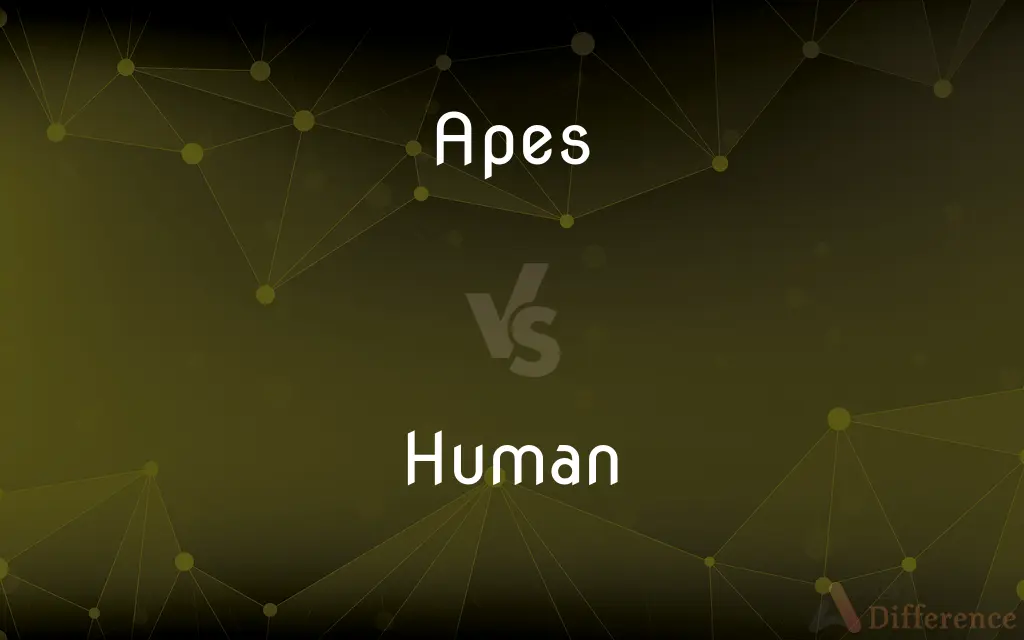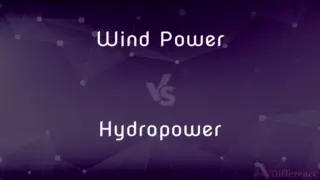Apes vs. Human — What's the Difference?
By Tayyaba Rehman & Urooj Arif — Published on August 7, 2024
Apes and humans share a common ancestry but diverge in cognitive abilities, physical characteristics, and societal development, with humans possessing complex language, advanced tool use, and intricate social structures.

Difference Between Apes and Human
Table of Contents
ADVERTISEMENT
Key Differences
Apes, including gorillas, chimpanzees, and orangutans, are our closest living relatives in the animal kingdom, sharing a significant percentage of DNA with humans. While apes exhibit some basic tool use and social behaviors, humans have developed advanced languages, technology, and societies. On the other hand, humans, belonging to the species Homo sapiens, have evolved to possess highly advanced cognitive abilities, enabling complex thought, communication, and problem-solving skills far beyond those of any other species.
Apes have strong physical abilities and are adapted to living in their natural habitats, with bodies designed for climbing and swinging from trees. In contrast, humans have evolved bipedalism, freeing their hands for tool use and enabling the development of technology. This physical difference underscores a significant divergence in lifestyle and capabilities.
Social structures in ape communities are complex, with defined hierarchies and social bonds; however, humans have taken social organization to another level with the creation of large-scale societies, governments, and cultures. This difference in social complexity is a key factor distinguishing humans from their ape cousins.
Language and communication in apes are limited to basic signs and gestures that convey immediate needs or emotions. Humans, however, have developed intricate languages capable of expressing abstract concepts, emotions, and complex ideas, facilitating the development of culture, art, and science.
The ability to use and create tools is present in both apes and humans, but the complexity and variety of tools humans use are unparalleled. Early humans' development of tools marked a significant evolutionary step, leading to technological advancements that have shaped the world.
ADVERTISEMENT
Comparison Chart
Physical Abilities
Adapted for arboreal life; strong limbs for climbing.
Bipedalism allows for free use of hands; less physical strength compared to apes.
Social Structures
Complex hierarchies and social bonds within small groups.
Highly complex societies with diverse cultures and governments.
Language
Basic communication through gestures and sounds.
Advanced language capable of expressing complex ideas and emotions.
Tool Use
Basic tool use, primarily for foraging.
Advanced tool use and technology development.
Cognitive Abilities
Exhibits intelligence and problem-solving within environmental context.
Highly advanced cognitive abilities, including abstract reasoning and creativity.
Compare with Definitions
Apes
Primates with strong physical abilities and basic tool use.
Chimpanzees use sticks to extract termites from mounds.
Human
Possess advanced cognitive skills and language.
Humans have developed thousands of languages and writing systems.
Apes
Social animals forming complex communities.
Gorillas live in groups led by a silverback.
Human
Use sophisticated tools and technology.
Humans use computers and smartphones for communication.
Apes
Communicate using gestures and vocalizations.
Orangutans use specific sounds to alert others to danger.
Human
Live in complex societies with diverse cultures.
Human societies range from small tribes to large nations with intricate laws.
Apes
Primarily arboreal, living in forests and jungles.
Bonobos swing from tree branches in the Congo basin.
Human
Capable of abstract thought and creativity.
Humans create art, music, and literature.
Apes
Capable of learning and problem-solving.
Apes can solve puzzles to get food rewards in research settings.
Human
Bipedalism frees hands for tool use and creation.
Humans developed tools from simple stones to spacecraft.
Apes
Any of various tailless Old World primates of the superfamily Hominoidea, including the gibbons, orangutans, gorillas, chimpanzees, and humans.
Human
A member of the primate genus Homo, especially a member of the species Homo sapiens, distinguished from other apes by a large brain and the capacity for speech.
Apes
Any of various members of this superfamily bearing fur and usually living in the wild, especially orangutans, gorillas, and chimpanzees, in contrast to humans. Not in scientific use.
Human
Belonging to man or mankind; having the qualities or attributes of a man; of or pertaining to man or to the race of man; as, a human voice; human shape; human nature; human sacrifices.
To err is human; to forgive, divine.
Apes
To imitate or mimic, especially in a thoughtless or inept way.
Human
Any living or extinct member of the family Hominidae
Apes
Plural of ape
Human
Having human form or attributes as opposed to those of animals or divine beings;
Human beings
The human body
Human kindness
Human frailty
Common Curiosities
What makes humans different from apes?
Humans are distinguished from apes by their advanced cognitive abilities, complex language, sophisticated tool use, and the development of intricate societies.
Can apes communicate like humans?
Apes can communicate using basic gestures and sounds, but they do not possess the complex language capabilities of humans that allow for the expression of abstract concepts.
Do apes have cultures?
Apes exhibit some elements of culture, such as tool use behaviors and social practices that vary between groups, but human cultures are far more complex and varied.
What is the role of social structures in human evolution?
Complex social structures have played a critical role in human evolution by facilitating the development of communication, cooperation, and cultural diversity.
What is the significance of tool use in human evolution?
Tool use is significant in human evolution as it led to technological advancements, improved hunting and foraging methods, and influenced brain development.
What role does creativity play in human societies?
Creativity is fundamental to human societies, driving innovation, cultural expression, and problem-solving, distinguishing humans from other species.
Do apes use tools?
Yes, apes can use basic tools, primarily for foraging, but their tool use is not as advanced or varied as human tool use.
Are humans stronger than apes?
Physically, apes are generally stronger than humans, especially in upper body strength, due to their arboreal lifestyle and evolutionary adaptations.
How are humans and apes similar?
Humans and apes share a common ancestry, resulting in similar genetic makeup, social behaviors in forming bonds and communities, and the ability to use tools.
Why can humans walk on two legs?
Humans evolved bipedalism to free their hands for tool use and to cover long distances more efficiently, which was advantageous for foraging and migration.
Can apes learn human languages?
Apes can learn a limited number of signs or symbols in controlled research settings, but they cannot grasp the full complexity of human languages.
How do human brains differ from those of apes?
Human brains are larger in relation to body size, with more developed areas responsible for reasoning, planning, and language, supporting higher cognitive functions.
Why do humans have less hair than apes?
Humans evolved to have less body hair, which may have helped in temperature regulation and reduced the prevalence of parasites, aiding long-distance endurance running.
How have humans impacted the planet compared to apes?
Humans have had a profound impact on the planet through urbanization, environmental change, and technology, whereas apes have minimal impact, living in harmony with their natural habitats.
How does the diet of humans compare to that of apes?
While apes primarily have a plant-based diet, humans have adapted to a more varied diet that includes meat, which has influenced human evolution and societal development.
Share Your Discovery

Previous Comparison
Graphic Card vs. Video Card
Next Comparison
Wind Power vs. HydropowerAuthor Spotlight
Written by
Tayyaba RehmanTayyaba Rehman is a distinguished writer, currently serving as a primary contributor to askdifference.com. As a researcher in semantics and etymology, Tayyaba's passion for the complexity of languages and their distinctions has found a perfect home on the platform. Tayyaba delves into the intricacies of language, distinguishing between commonly confused words and phrases, thereby providing clarity for readers worldwide.
Co-written by
Urooj ArifUrooj is a skilled content writer at Ask Difference, known for her exceptional ability to simplify complex topics into engaging and informative content. With a passion for research and a flair for clear, concise writing, she consistently delivers articles that resonate with our diverse audience.













































